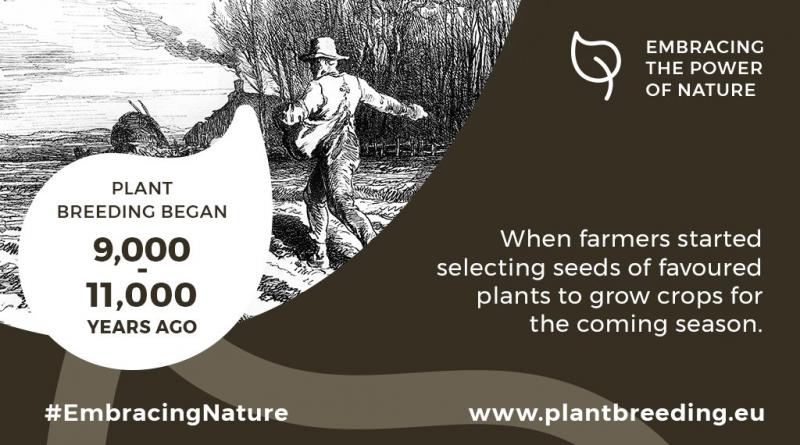
#EmbracingNature?
Biotech industry spin seeks to exempt new GMOs from regulation
In May 2017, the global biotech and seed industry lobby groups landed in Budapest for their annual congress. They launched a joint campaign with one key goal: to get governments worldwide to adopt a zero-regulation approach to new genetic modification (GM) techniques, often termed gene-editing techniques. The seed industry magazine SeedWorld stated that the timing of this international campaign is critical “as policymakers and governments around the world discuss plant breeding innovations, and if and how they should be regulated”.
Consumer resistance to genetically modified organisms (GMOs) is strong in Europe, and there is next to no cultivation nor human consumption of GM food. The biotech industry is therefore working hard to convince decision makers and the public that the products of these new GM techniques can go without safety checks and labeling.
To this end, a global seed lobby group the International Seed Federation (ISF) produced an internal communication toolkit giving seed companies detailed instructions and PR tricks for communication about new GM techniques. Their key message should be: new technologies, like oligonucleotide-directed mutagenesis (ODM), CRISPR-Cas9 or zinc finger nuclease (ZFN), are just a simple continuation of the classical plant breeding “that humankind has done for thousands of years”. “What we’re doing is basically boosting Mother Nature to a degree, just in a more efficient manner,” said Bayer’s head of agricultural research, Adrian Percy in The Wall Street Journal.
Another internal industry report done by Brussels-based consultancy FTI Consulting provides companies with a detailed mapping of the political and public debate on new GM techniques in ten EU countries.
Imposing safety tests on these products in the same way as is done for older GMOs, industry lobbyists say, would stifle innovation, hurt competitiveness and lead to disruptions in international trade. Industry claims that only techniques that will escape GM safety checks will be commercially successful. According to SeedWorld “regulatory policy will determine the methods used across companies and across crops”. While they should not be treated as GMOs when it comes to food and environmental safety, industry’s wish-list includes full intellectual property protection through patents, just like GMOs. The idea that farmers would replant seeds from their crops – as they have also done for thousands of years – without paying royalties, is something the seed industry wants to prevent at all costs.
The industry tries to convince regulators that products from gene-editing and other new GM techniques do not need safety checks if they are “similar or indistinguishable” from varieties that “could have been produced through earlier breeding methods”. They are referring to an exemption made in the 2001 EU GMO law for so called mutagenesis techniques applying high levels of radiation or chemicals to organisms or their cells. This exemption, lobby groups claim, should now be extended to new GM techniques.
But this would mean that plant breeders, farmers, food processors and consumers are losing their right to chose and take a well informed decision about the products they want to work with. From a biosafety perspective too, regulation of products of new GM techniques is needed, says the European Network of Scientists for Social and Environmental Responsability (ENSSER). Since these techniques are genetic modification procedures, “such techniques give rise to predictable as well as inadvertently generated risks when used in a context of agriculture, conservation or ecological management”, these critical scientists say. Therefore, the products of new techniques “should be at least as stringently regulated as the organisms produced with the transgenic methods used in currently commercialized GMOs”.
In Europe, as in most places, there is as yet no legal clarity as to how new GM techniques will be dealt with. The European Commission never succeeded in producing a proposal for how to deal with this. The waiting is now for a ruling from the European Court of Justice (ECJ) following questions from the French Council of State. This ruling is expected by summer 2018. Then, EU decision makers will still need to hammer out crucial details. This could lead to new court cases because it is clear that, whatever the outcome, there will be winners and losers: in terms of company profits and in terms of environmental and food safety, and consumer choice.
| The global biotech and seed industries have already tried various strategies to get this entire generation of techniques excluded from any regulation. In CEO’s 2016 report “Biotech lobby’s push for new GMOs to escape regulation” and several follow up articles, we have described the different strategies developers use to achieve that aim in Europe. These strategies included many meetings with DG SANTE, pushing Member States to allow field trials in a de-regulated fashion, and pressure from trade partners like the US Mission to the EU in the context of TTIP negotiations. |
New biotech PR tools: avoiding the GMO rabbit hole
The International Seed Federation (ISF), its US and EU member associations ASTA and ESA, and CropLife International (which combines biotech and pesticide companies at a global level) in 2017 developed an internal communication toolkit that was “designed to support ISF’s allies and partners in their outreach across their own networks, to their country’s policymakers” and to have them “aligned world wide”, said Jennifer Clowes, ISF’s communication manager. The key members of these lobby groups are the big names in biotech and pesticide production: Monsanto, Syngenta, ChemChina, DowDuPont, Bayer, BASF, along with seed multinationals like Limagrain, KWS Saat and Rijk Zwaan.
One year earlier, DowDuPont hired a consultancy to conduct roundtable discussions on gene editing, The Wall Street Journal reported. WSJ also reports that Bayer has set up an “Ambassador Program” to coach scientists for public speaking events on new GM techniques, similar to its 2012 “Bee Ambassador Program” set up to “establish dialogue” in the midst of the pollinator crisis.
The ISF discussion guide provides companies with detailed advice on how to set the tone for a public discussion on new GM techniques. Any communication on the subject needs to demonstrate “confidence, intelligence and optimism”. Technical jargon should be avoided, language should be simplified to suit the audience but “without patronizing them”.
Speakers should to stay calm and collected: “it’s a conversation, not a conflict, and don’t be too clinical”. One should “adapt to the needs of the audience and show them you’re interested in them”. Put positive energy into your words, and use storytelling techniques to share insights and “fascinating facts about plant breeding innovation”, such as: “Did you know that we’ll need to feed around 9 billion people by 2050? The good news is that plant breeding innovation is helping farmers grow more food on existing land with optimized inputs to increase food security.”
Seed companies are told: talk about “plant breeding innovation”, “methods” or “tools” but not techniques or technologies. Describe them as “most recent” or “improved”, not as new. And say that new GM varieties are “developed”, not created.
When the toolkit was launched at the 2017 ISF congress in Budapest, Jennifer Clowes said that “the toolkit was put into practice with a personalized training session for 50 secretary generals of national and regional seed associations. Delivered by two BBC media trainers, the session included practical tasks on message mapping and interview skills.” The four seed industry lobby groups then embarked on social media campaigns to amplify the common messages from the toolkit.
Remember Darwin and Mendel...
The ISF guide draws on a very old claim by the GM industry that genetic engineering is simply an extension of what farming communities have done since the beginning of agriculture. The ISF discussion guide claims that the new techniques “are based on the same plant breeding principles farmers and plant scientists have used for thousands of years: planting seeds, observing the characteristics and selecting the most desirable”. Linking the new GM techniques to the history of plant breeding is a PR-tactic aimed to make new GMOs sound safe by nature.
“Plant breeding innovation” is therefore put forward as a key term to “reflect the continuum of innovation in plant breeding” and “set the tone for an open dialogue about the evolution”. Charles Darwin’s evolution theory and Gregor Mendel’s discovery of the basic principles of the inheritance of genetic traits are invoked to create the impression that there is nothing new in these techniques.
However, in an article in The Wall Street Journal, Professor Jennifer Kuzma, co-director of the Genetic Engineering and Society Center at North Carolina State University, is quoted as saying that referring to the new gene-editing techniques as breeding “seems a little disingenuous”. “It is a biotech-improved crop. Something along those lines would be more honest and is more likely not to come back and bite them in the future if consumers find out it is not really just breeding, it’s something more.” Indeed, new techniques like CRISPR are often hailed in academic or industry publications as a "disruptive enabling technology" or as "revolutionary".
In the ISF infographic below, the ever-broader yellow band refers to new technologies being added to cross‑breeding and selection, the basis of plant breeding in agriculture. But it seems that the users of new GM techniques precisely wish to avoid any breeding, and prefer to quickly build a new (patented) trait into existing commercial varieties. This picture hides the vast number of food crops used and the genetic variety within each crop developed by farmers over the centuries, many of which have disappeared from fields and diets - a genetic erosion of very serious proportions caused by the very industrial model of agriculture the companies controlling the techniques aim to keep in place.
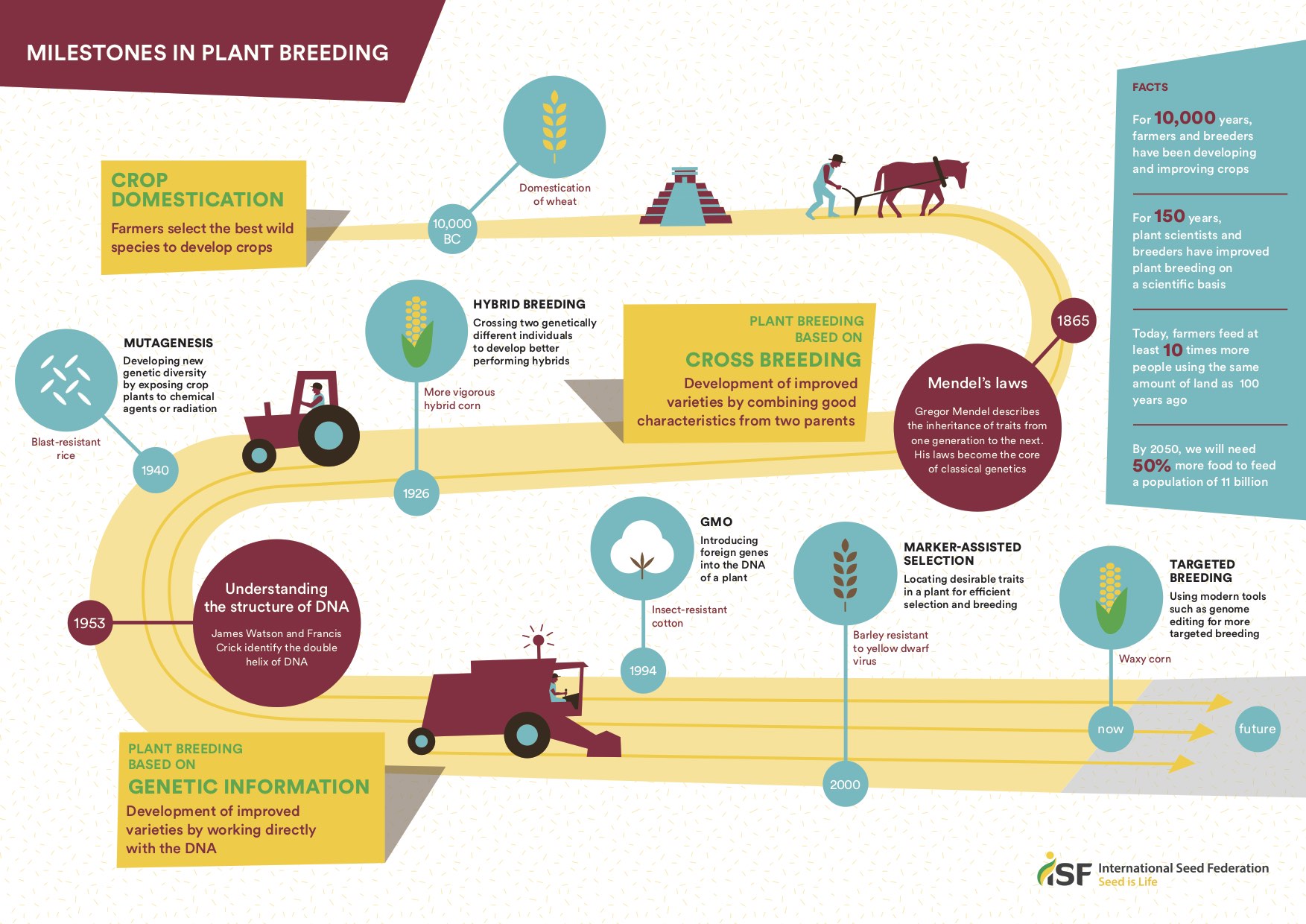
International Seed Federation website (www.worldseed.org).
Infographics like these are part of the ISF toolkit and has been adapted and translated into other languages by national seed associations in The Netherlands (Plantum), France (UFS) and Germany (BDP), and used in their national communications. According to Jennifer Clowes, the infographics “have been widely used in academia, including the University of Ghent and the Danish Technological Institute, and have also proved to be a hit on social media”.
Even within the industry, not everyone seems to agree that this message will effectively convince the wider public. A DuPont presentation titled “From Cautiously Optimistic to Acceptance: CRISPR-Cas Qualitative Message Testing”, obtained by US researcher Edward Hammond via freedom of information requests, sums up the results of a survey held amongst “millennial influencers” in the US. The conclusion is that using the “10,000-year old tradition of breeding” message was a no-go since “people don’t believe that story”. So, will it work among Brussels’ politicians and officials?
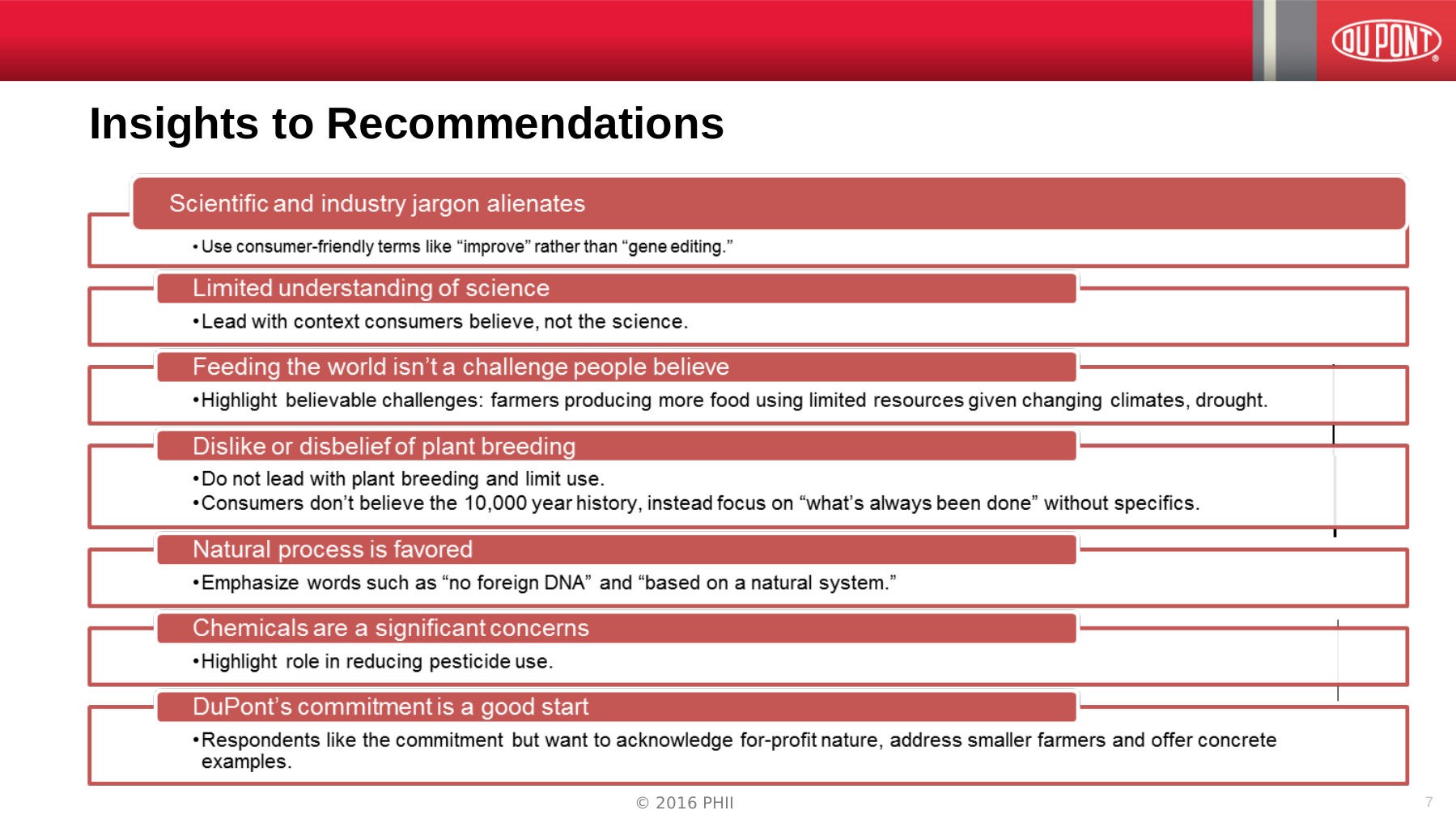
Claims of benefits
The ISF discussion guide spells out different apparent benefits with precise headline messages and supporting statements attached to them and adapted to the target group that is supposed to benefit: consumers, farmers or those who support environmental protection.
The previously mentioned DuPont presentation shows that also the “feeding the world” narrative would no longer be credible to citizens. Focusing on such altruism has made consumers more sceptical, it seems. Julie Borlaug, head of public relations of gene-editing company Inari Agriculture and granddaughter of green revolution pioneer Normal Borlaug, does not believe that argument “will persuade sceptical U.S. consumers”. “The consumer’s looking for a new and different way of agriculture, and it’s hard for the big [companies] to do a 180”, she told WSJ.
The industry is therefore looking for other angles to present the benefits of GM products, that link to current crises or consumer interests. Consumers are told for instance that new GM products will contribute to their “health and well being” and will provide “longer lasting, fresh and nutritious” food, as well as fuel or fibre. Examples include “vegetables with a higher resilience to transport” or “optimized biofuels”.
Another claim, directed to farmers, reads: “plant breeding innovation provides yield stability, despite a changing climate”. As a supporting statement, it is said that food production can be increased under environmental stress factors like climate change, and that plants can be produced “that survive or even thrive in extreme weather conditions”. Yet a note is made to this section saying that “while it’s good to communicate excitement, be careful not to over-promise on the benefits it can bring”. However, as Lawrence Woodward wrote in The Ecologist, “Drought tolerance is a complex trait that involves multiple genes and genetic engineering techniques which target one gene is taking longer and is significantly less effective [than conventional breeding]”.
Yields, it is claimed, can be increased by new techniques, and “this means that more forest, flora and fauna can remain untouched”. But this ignores the fact that as long as the same few profit-oriented companies controlling these technologies have an interest in the expansion of the commodities market, there is no guarantee whatsoever that these areas will really be protected.
Indeed, it was precisely the combined impact of population growth and finite resources, such as land and water, that made HSBC banker Allan Wilkinson in 2016 predict “a very positive future for plant breeding innovation in the years to come”. He adds that “successful innovation will be concentrated in the hands of fewer players”, contradicting often-heard claims that the deregulation of new GM techniques will specifically offer chances for small and medium-sized companies (SMEs).
But how many of the predictions will come true? It seems that herbicide tolerance is still the industry’s top priority. The first commercial application of new GM techniques in the pipeline is by the US company, Cibus, which has made oilseed rape tolerant to sulfonylurea-based herbicides, using the ODM technique. As BASF is buying up seed assets from Bayer to allow for the Bayer-Monsanto merger, its Vice Chairman Martin Brudermueller recently told Bloomberg that “gene editing tools such as CRISPR-Cas will help BASF develop seeds designed to work with crop chemicals”.
The European campaign: #EmbracingNature
The communication plan in the ISF discussion guide is neatly followed in the European seed industry lobby campaign for the deregulation of new GMOs. The European Seed Association (ESA) launched a dedicated website (plantbreeding.eu). Brussels-based lobby consultancy, ZN Consulting, was charged with designing a digital campaign using the hashtag #EmbracingNature. The campaign, titled “Embracing the Power of Nature” portrays new GM techniques as “working with nature’s genetic diversity”, a simple continuation of what farmers and plant breeders “have been doing for thousands of years”.
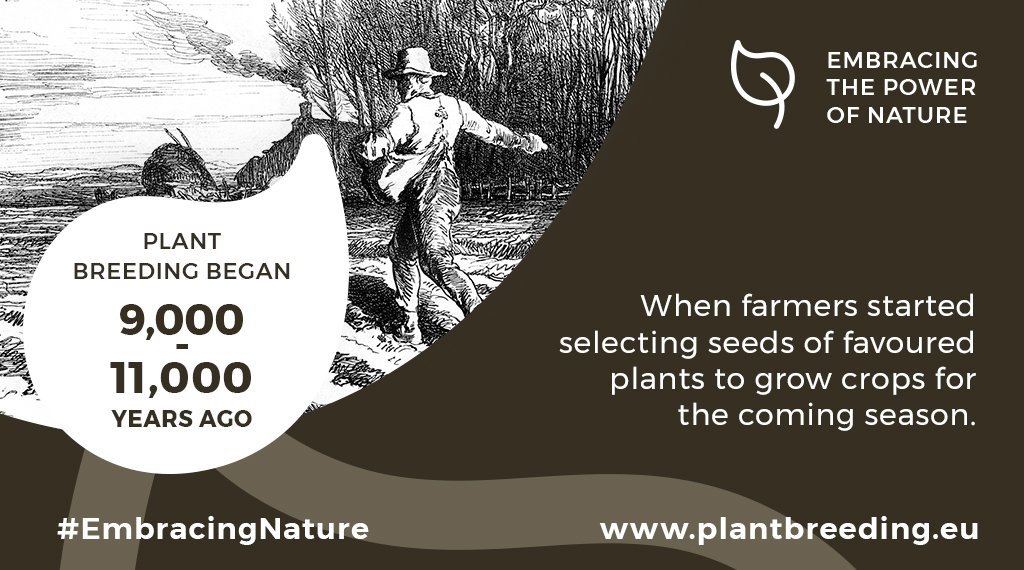
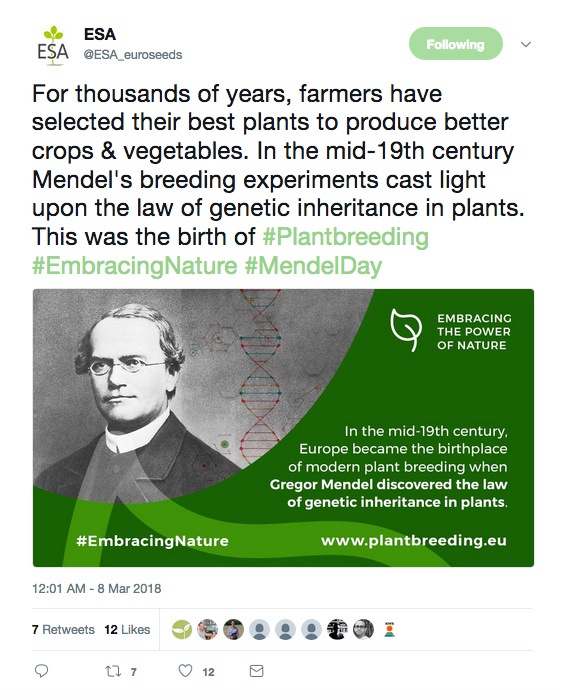
ZN Consulting, which describes itself as “the digital communication agency in Brussels”, is not registered in the EU transparency register. Its portfolio includes clients from the alcohol, food and drink and pesticide industry as well as the EPP, the conservative group in the European Parliament. The company designed a twitter campaign with the goal “to start changing the conversation” about new GMOs.
ZN Consulting organised a “digital activation jam” in late August 2017, an occasion “when you get people in the room to push the message, get the story out there, and learn impact of Twitter can really start changing the conversation”, says Philip Weiss, the firm’s chairman and “chief hyperthinker”.
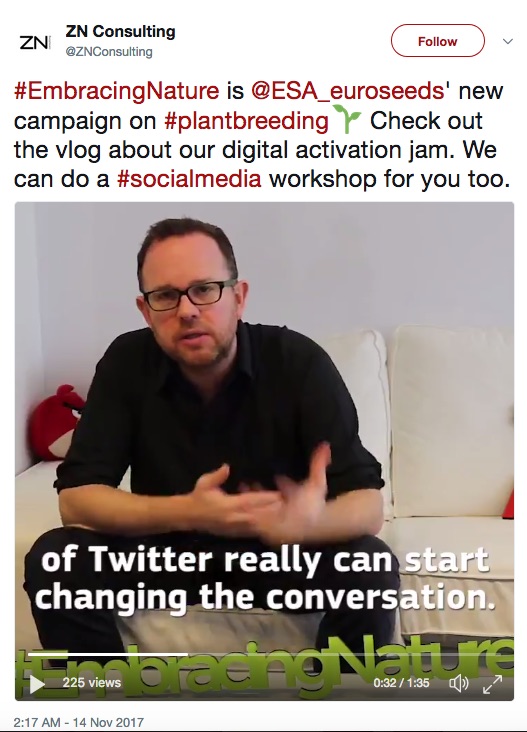
In a vlog produced about this event, lobbyists from DowDuPont, Syngenta, ECPA and big farm lobby agency, COPA-COGECA, can be seen brainstorming on what messages to use for a European audience, jotting down PR ideas including: “get parents engaged”, “stress benefits for kids”, “EU farmers, young and trendy”, and, ironically, “Not Just Big Corporations”.

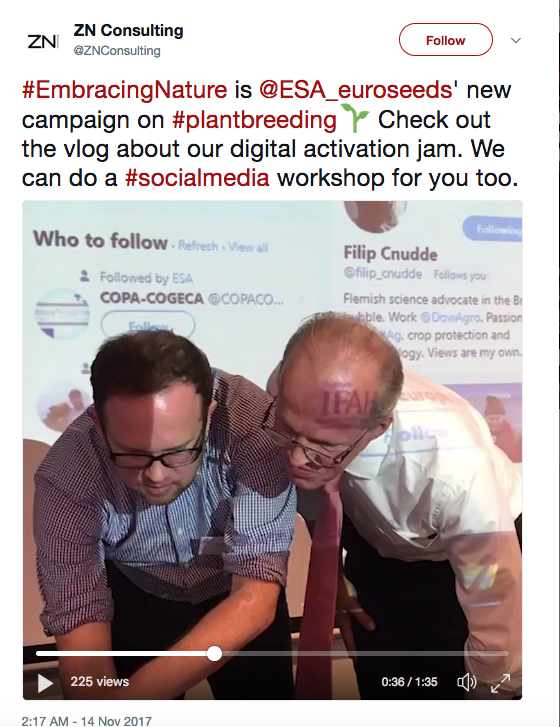
The #EmbracingNature campaign tweets have been retweeted mainly by British, Dutch, Polish and Italian seed lobby groups, and by German seed multinationals like BASF and KWS Saat.
The European biotech and seed industry uses another internal lobby tool, seen by Corporate Europe Observatory: a stakeholder and issue mapping report by Brussels-based lobby firm FTI Consulting. Also dated April 2017, the report collects intelligence on the state of play of the new GM debate in ten EU countries and includes official statements by national ministries and agencies, scientists, farmers, grain and feed producers, NGOs, as well as media coverage. It is unclear who commissioned the report, but Bayer and EuropaBio are amongst FTI’s clients, according to the EU transparency register.
FTI’s conclusion was that “in most cases the discussion is spearheaded by politicians. The positive voices – farmers and scientists – have not received enough online attention even though they outnumber NGOs. This suggests that NGOs have had a more successful communication on the topic and might become louder than the NBT [new breeding techniques] supporters”. In addition, as none of the ten countries had yet adopted a definitive position on new GMOs and were still consulting stakeholders, the report concludes there is still “a window of opportunity for the seed industry to change the narrative”.
What’s in a name?Different players use different terms in this debate:
To make things more complex, not all of these techniques are even new. Cisgenesis, for instance, makes use of old, standard GM techniques but is said to avoid the mixing of DNA from different species. |
End-goal: no safety tests or labeling
After this extensive advice on narrative change for consumers and farmers, the discussion guide proposes a different communication strategy towards officials and decision makers. Well informed political or government science advisors can be addressed with language that “is technical and not intended for the general public”. Arguments can include benefits for the national economy, cheap food for consumers, better seeds for farmers and the cause of international free trade. The impact of requesting safety checks on GMOs is said to be detrimental to these concerns.
The competitiveness argument is already being heard at the national level. The FTI Consulting mapping report lists claims that new GM techniques would be “needed for the UK’s productivity”, would “contribute to the competitiveness of German farmers”, would be “tools that French researchers should be able to continue using” and “it is important that Dutch companies continue to research innovative plant breeding”.
As the way forward, the ISF proposes a set of so-called “consistent criteria for regulatory oversight”. The words have been carefully chosen: while they suggest some form of oversight, these criteria would result in exactly the opposite: zero regulatory oversight for the products of new GM techniques, therefore no safety assessment, no traceability and no labelling for consumer choice.
At an International Life Sciences Institute (ILSI) workshop in July 2017, Bernice Slutsky of the American Seed Trade Association (ASTA) explained that, according to this proposal, products would not have to be regulated as GMO if:
- they do not contain a “novel” combination of genetic material, or
- if the final plants solely contain inserted material from sexually compatible plants, or
- any form of mutagenesis is involved
Or as presented in the ISF discussion guide (p.10):
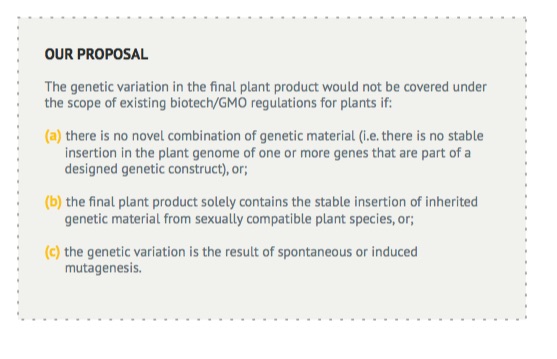
This would be a radical deviation from how the EU currently regulates GMOs. At present, when a GM process is used, the legislation has to be applied. The industry approach only focuses on the final product and lets most techniques off the hook. The call to move from process to product-based legislation is often heard among GM developers.
Ad a: By saying that a plant contains “no novel combination of genetic material”, industry concludes that it is “similar or indistinguishable” from plants that could have been produced through earlier breeding methods or by natural genetic variation. But how does one prove that? Scientist organisation ENSSER points out that these techniques are being developed to be used repetitively, or in combination. While one individual change could be "indistinguishable", many small changes can collectively lead to an organism that is entirely unknown. Using the techniques may also produce off-target effects, such as altering the DNA in additional places to those intended, which need to be investigated.
Ad b: The second criterion lets techniques off the hook that use old-fashioned GM techniques but using material from within a species (“no foreign genes”). Current EU rules regard products from these techniques as GMOs and have to be regulated as such.
Ad c: New techniques like CRISPR-Cas9 are now dubbed targeted or induced mutagenesis, and are boxed together with old mutagenesis techniques that were exempted from regulation. There is currently no legal definition of mutagenesis, but environmental NGOs, farmers and scientists have said that the exemption for the old mutagenesis can in no way be applied to new techniques for which there is no experience or evidence of their safe use.
Throughout the discussion guide, ISF encourages its members to change the terms of the debate: “The question is not whether there is adequate regulation of foods and plants, but the extent to which a safety evaluation is justified”. Without safety checks, they argue, people could still be assured of safety because plant varieties would be covered by “other pieces of legislation”. They refer, for instance, to the obligatory seed variety registration seed catalogues. In October 2017, the European Commission echoed industry’s line of “no regulatory void” at a hearing in the case currently ongoing at the ECJ.
However, none of these “other” pieces of legislation provide any food or environmental safety guarantees. This was pointed out by French farmers’ organisation Confédération Paysanne, main party in the ECJ case, who argued, for instance, that the plant variety laws only verify homogeneity of seed, not their safety. This view is supported by a legal opinion published by the German federal agency for nature conservation, BfN. This opinion looked at several seed-related laws and concluded that these are “neither individually nor collectively able to ensure an assessment and control of possible negative environmental impacts”.
Crucially for the industry, this zero-regulation approach should be aligned internationally to, supposedly, avoid barriers to trade. Therefore, ISF proposes additional elements for the implementation and harmonisation of the industry’s favoured approach to deregulation. This includes, for example, industry-designed definitions, applied timelines and, of course, mutual recognition of other countries’ decisions regarding each technique.
This comes as no surprise since a series of internal Commission documents obtained under freedom of information rules revealed intense lobbying by US representatives during TTIP negotiations for the EU to disregard its GMO rules. Indeed, it is fully in line with current attempts to align the way risky products are regulated world wide through trade negotiations ("once approved here, approved everywhere").
As an example COCERAL, the grain traders lobby group, argues that “regulatory coherence with the rest of the world [is] of paramount importance to enable trade to continue efficiently, without facing hurdles”.
Conclusion
The issues at stake are very serious and concern what food is grown, what we eat, what we are allowed to know about it, and who controls all of that. How will citizens be informed and included in the crucial decisions that will have to be made on how these techniques are governed? Which interests will be served? Empty PR slogans as used in the corporate #EmbracingNature campaign are not the answer. We should be embracing nature by protecting (agro)biodiversity, soil quality, water supplies, avoiding disastrous climate change and making the transition to sustainable and fair farming systems.
